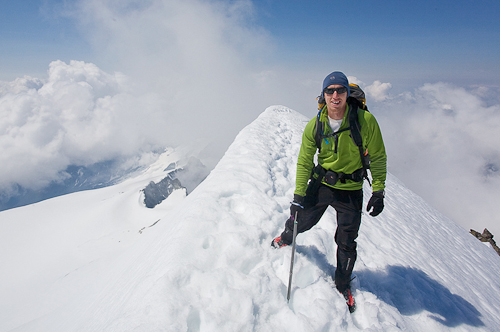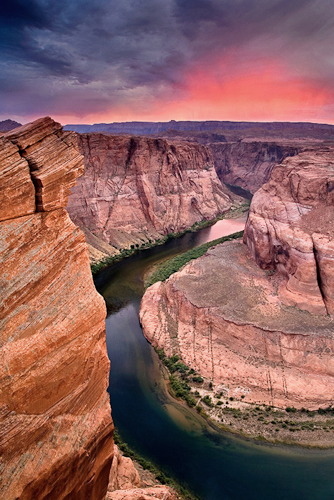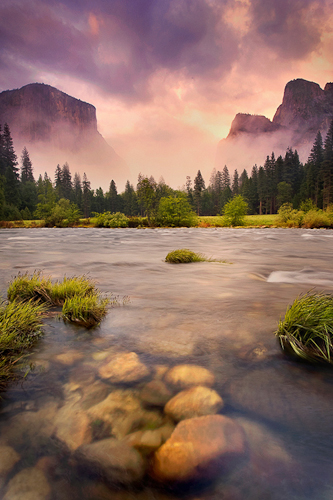Scott Hotaling loves nature and outdoor activities and photography was a natural extension of his passions. Scott’s love and appreciation for nature can be clearly seen in his beautiful photographs. I was lucky to get an interview with him, and without further adieu please welcome Scott Hotaling!
Click on the photo to enlarge.
Tell a little about yourself. What do you do for a living? How did you get involved with photography?
I’m a North Carolina native and I’ve spent a majority of my life exploring the southern Appalachian mountains. Despite a good bit of travel across North America and stints living elsewhere I still consider western North Carolina my home. Currently, I’m spending several months focusing solely on my landscape photography work but in January, I’ll be starting a doctoral graduate program in Lexington, Kentucky. So, for the time being, I’m working solely as a photographer for the first time in my career. As for getting started, it was simple cause-and-effect for me. I loved exploring new places but never managed to shoot photographs that translated the beauty I found to those around me. Most of the time I’m still trying to figure it out but every once in a while I luck into something good.
Photo by Scott Hotaling. Click on the photo to enlarge.
How do you pick your spots for taking pictures?
For me to do my best work I have to be physically drawn to a place. It’s not uncommon for me to visit a location ten or more times under a variety of seasons/conditions before I get the photo I’m after. The process can take years but it’s one I respect and enjoy. But despite frustrations and bumps along the way, at the core of it all, is a deep appreciation for a specific place and the desire to showcase it under optimal conditions. I carefully construct what the perfect conditions would be for a location in my head then do my best to capture them. In most cases, the right conditions include a certain season, landscape condition (fall color, fresh snow, etc.), time of day, cloud cover, and more.
Photo by Scott Hotaling. Click on the photo to enlarge.
What inspires you to take photos?
The natural world and the infinite combinations of light, dark, rock, plant, water, etc. that make every photograph different from the next. From a microscopic to global scale we live in an incredible place and I want to see as much of it as humanly possible, my camera simply comes along for the ride.
But, specifically, I’m particularly drawn to places with dramatic views – mountain summits, ridges, cliffs, etc. And, particularly those that aren’t easily accessed or less widely known. For example, a winter sunrise from a remote mountain summit is the best case photographic scenario I can envision.
Do you hike and photograph alone, with someone, or in a company?
Usually alone. More by necessity than choice, my schedule and plans dictate my hiking company more than my personal preference. But, I’ve been lucky to have a wide variety of wonderful people join me for adventures and that’s always much more fun.
Photo by Scott Hotaling. Click on the photo to enlarge.
What photographic equipment do you use and for which tasks?
I like my kit to be simple. I don’t need nor want a bunch of stuff to lug around. My workhorse camera is the Canon 5D. I don’t subscribe to manufacturer debates over which system is better – it’s all the same to me. My 5D has gained my respect over the years because I can’t seem to break it. It falls on icy glaciers, gets soaked in the rain, sees temperatures below 0° F regularly in the winter and despite plenty of other daily torment, it never misses a beat. When it does finally die, that’ll be fine, I’ll just get another one.
From a lens perspective, people are often surprised to find out that I only have two – a Canon 17-40 f/4 L and 70-200 f/4 L. Much like my camera bodies, my lenses take a good deal of abuse and don’t seem to mind.
The often unheralded piece of gear in my bag that truly does the dirty work are my HiTech neutral density filters. I carry five, four graduated and one non-graduated, and use them nearly every time I’m out. My sunrise and sunset photos would be impossible to capture in one exposure (I don’t use any HDR or similar techniques) if it weren’t for those filters. I highly recommend any beginning landscape photographer look into purchasing a set.
Photo by Scott Hotaling. Click on the photo to enlarge.
What is the average weight of your hiking backpack?
Average weight is a tricky subject. If I’m backpacking, my pack is probably in the 20-35 pound range depending on season and trip length. I try to stay as light as possible, despite carrying a tripod. If I’m only day hiking, I would venture a guess of 5-15 pounds.
I have this issue with tripods – I can’t find the perfect tripod for me. Which tripods do you use and why?
I’ve been using the same tripod for years. Many photographers would consider it too small, or too heavy, or too cheap but it works great for me. Both head and legs are made by Manfrotto – the head is a 466RC2 and the legs are model 3001BPRO.
Photo by Scott Hotaling. Click on the photo to enlarge.
Recently I wrote an article about using UV filters to protect lenses. What is your opinion on that issue? Do you use UV filters?
I don’t use UV filters at any time. The only use I see for one is protecting a lens when photographing in a place that has unavoidable, major hazards to the lens glass present. From a purely photographic standpoint, it doesn’t serve any purpose in my opinion.
Photo by Scott Hotaling. Click on the photo to enlarge.
Do you post process your photos? What software do you use, and what are the main adjustments that you perform?
I post-process all of my photos using Adobe Bridge for RAW conversions and Adobe Photoshop CS3 (or maybe 4?) for the rest. I avoid major processing work as much as possible – the tools I stick to are, in no particular order, spot removal, levels, contrast, color balance adjustments, and localized color tweaking. Dodging and burning is a major part of my processing as well and adds depth to the finished image.
Photo by Scott Hotaling. Click on the photo to enlarge.
If you had only two advices to give to a beginning landscape photographer, what would they be?
Get off the beaten path and shoot what you love.
Thank you Scott for this great interview. I hope to see more photos from you in the future.
If you liked Scott’s photographs, you can visit his website at















Very nice write up. Terrific photos Scott.
Great interview. Impressive photography. You asked some very basic…much-needed….questions and Scott’s answers were clear and easy to understand. I’m a novice photographer, just beginning to consider publishing some of my images. This interview has been a great source of information and encouragement. THANKS!
Great interview with Scott! Scott definitely practices what he preaches. The final line, “Get off the beaten path and shoot what you love,” should be every photographers mantra 🙂
Shawn, thanks for commenting. I checked out your website and you have good photos yourself!
Deborah, I am glad that you found this interview helpful – it is exactly what my interview are intended for.
Julie, I agree, but I think photographers should also have additional mantras 🙂
Very inspiring interview. Well written also.
Great Work,
Stas
Fabulous interview! Saw your tweet and followed the link here. I love the snow scene and thought it was my favorite, until I reached the waterfalls. Your style is wonderful and each image conveys a special mood.